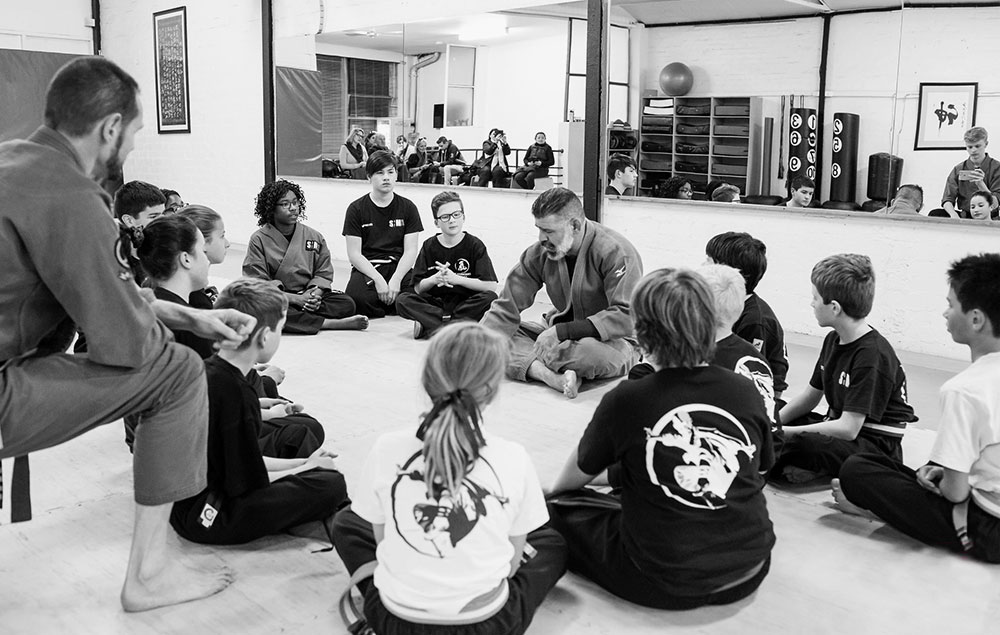BJJ - BRAZILLIAN JIU-JITSU
The Philosophy
Traditional Brazilian Jiu-Jitsu transcends chokes, pins, takedowns, locks and strikes. It was originally designed to prepare all of its students – regardless of size, age, or fitness level – for a more effective and efficient life.









Through the amazing techniques of Brazilian Jiu-Jitsu, a student can learn to expend much less physical, emotional and mental energy than usual. In a combat context, this leaves a great deal more energy to defend oneself; in a larger context, it frees a student’s energy from fear and anxiety, and allows them to live a more effective and happy life. If carried out to a natural, logical conclusion, Jiu-Jitsu can be applied as a life skill in nearly every aspect of our daily lives.
In the course of studying BJJ, all parties must benefit equally from the techniques and activities in the school. At Six Harmonies Jiu-Jitsu, this concept manifests itself as cooperation and a sense of community among our members. Our great training partners help to make us great – without a cohesive, cooperative environment, it is impossible to learn an art like Brazilian Jiu-Jitsu. It is our goal to foster a sense of trust, community and genuine love for Jiu-Jitsu in order to create a safe, efficient and effective learning environment for all our students.
Most commonly, “jiu-jitsu” is translated as “the gentle art”. It is difficult to pin down its exact origins. In fact, Brazilian Jiu-Jitsu has its roots in the Japanese Jiu-Jitsu of the early 20th century, and in Jigoro Kano’s massive renovation of the art during the latter part of the 19th century. Kano’s innovations in training techniques – including the addition of safe and controlled sparring in a grappling context, called “randori” – led to great advances in the martial arts, and would contribute to the development of Jiu-Jitsu in Brazil.
“Gentle art” conveys the central idea behind both classical Japanese and modern Brazilian Jiu-Jitsu – the idea of using strength in the most efficient way possible. Rather than resisting force with force, the practitioner uses efficient technique in an intelligent fashion to overcome raw strength and aggression. This is the philosophical core of Jiu-Jitsu; equipped with this principle, a smaller person can hope to defeat a bigger, stronger person.
The History and Origins of “Jiu-Jitsu”
During the early part of the 20th century, a Japanese Judo and Jiu-Jitsu expert named Maeda came to Brazil as part of a diplomatic mission. He became friends with a local politician named Gastao Gracie; Maeda offered to teach Gracie’s sons the art of Jiu-Jitsu. They became very proficient in Jiu-Jitsu, eventually opening their own schools and developing their own additions and modifications to the techniques they had been taught. As a test of their skills, the brothers fought many matches against other styles with great success. They based their developing martial art on this type of combat experience, a tradition which continues even today. As a result of this experience, they were able to continue to extend and modify the things they had learned from Japanese Jiu-Jitsu into a comprehensive, combat-realistic strategy for real-life, real-world self-defense.
WJJU Jiu-Jitsu
Professor Dunn and Professor Glick established WJJU to provide the most effective Jiu-Jitsu instruction in the world by giving students a safe, non-competitive, progress-oriented learning environment. Jiu-Jitsu has been tested and proven as one of the world’s most efficient, effective system of self-defense through the ongoing pursuit of excellence among the Gracies and their black belt students, and through the introduction of ground grappling into the training regimen of nearly every major martial art worldwide.
Both Professor Dunn & Glick are 2nd degree Black Belts under Master Renzo Gracie & Professor John Danaher. Through their diligent study and practice of the art over the past 25 years Professor Dunn & Glick run five successful Brazilian Jiu-Jitsu academies in Brooklyn, New York.
Since 2008, Shifu Stuart has undertaken their guidance and the teaching philosophies of Professors Dunn & Glick and is currently the rank of Brown Belt. He also is an affiliate member with the World Jiu-Jitsu United group and the Australian representative.


